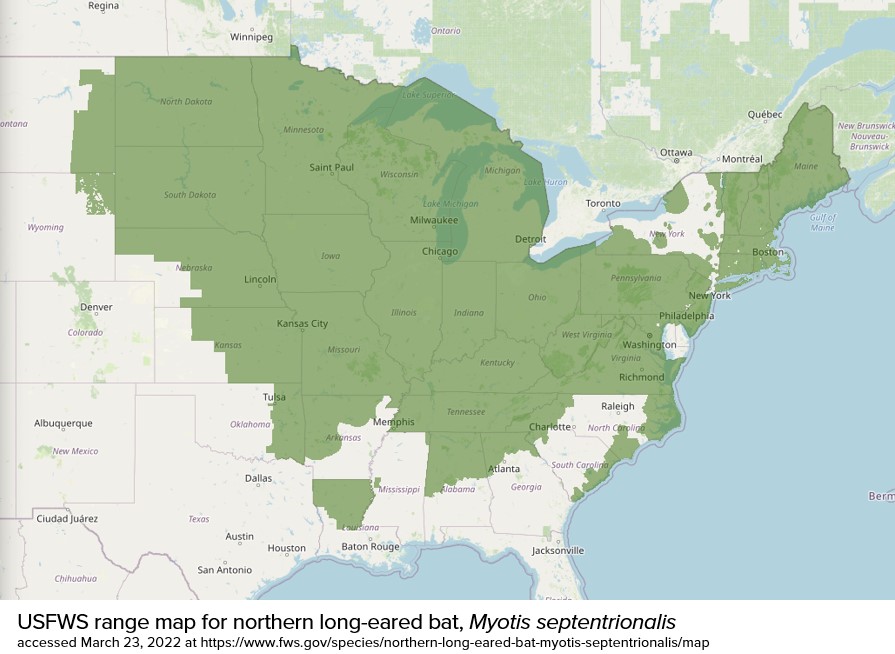Updated January 25, 2023
The U.S. Fish and Wildlife Service (USFWS) published the final endangered species listing for the northern long-eared bat (Myotis septentrionalis) today, a much-anticipated action since the proposed rule was pushed out in March of this year. Update, Jan. 25, 2023: A delay is slated for publication in the Federal Register on January 26, 2023 clarifying that the final rule will go into effect on March 31, 2023, rather than the originally published effective date 60 days from publication (January 30, 2023).
WSSI is tracking this closely as much remains to be determined by the USFWS before the effective date. Topics include definitions on “minor clearing,” potential timing for projects coordinated under the 4(d) rule, and potential changes to the Time of Year Restriction dates.
What Does the Listing Do?
The listing officially changes the legal status of the northern long-eared bat from threatened (with a 4(d) rule) to endangered. While the 4(d) rule under the threatened listing gave opportunities for many projects to continue under normal schedules (i.e., no time of year restrictions (TOYR) on activities such as tree clearing), the endangered listing does not allow for a 4(d) rule, thus, any projects that have the potential to impact suitable habitat (forested areas with trees measuring 3 or more inches in diameter) will need to coordinate with the USFWS.
How Does This Affect My Projects?
Under Section 7 of the Endangered Species Act (ESA), projects that require a federal action (such as work on National Park Service lands, NEPA approvals, wetland permits, construction or maintenance of roads by the Federal Highway Administration) may need to coordinate with the USFWS regarding the potential for “take” of this species if suitable habitat is present within the project area. The USFWS is defining suitable habitat as: forested/wooded habitat as containing potential roosts (i.e., live trees or snags greater or equal to 3 inches in diameter at breast height that have exfoliating bark, cracks, crevices, or cavities), as well as forested linear features such as wooded fencerows, riparian forests, and other wooded corridors. Projects that do not require a federal action may still need to coordinate with USFWS under Section 10 of the ESA to determine if the action is allowed or if an Incidental Take Permit will be required.
While not listed in the final rule, we expect there to be a TOYR on tree removal for all areas where suitable forested habitat is present. The USFWS also mentions that a Decision Key (Dkey) will be available in the near future to assist with determinations regarding the potential to affect this species during the Section 7 consultation process.
Exceptions
The final rule mentions a number of actions that would not constitute a “taking” including:
- Minimal tree removal and vegetation management activities that occur any time of the year outside of suitable forested/wooded habitat and more than 5 miles from known or potential hibernacula.
- Insignificant amounts of suitable forested/wooded habitat removal provided it occurs during the hibernation period and the modification of habitat does not significantly impair an essential behavior pattern such that it is likely to result in the actual killing or injury of northern long-eared bats after hibernation (note that the USFWS does not define “insignificant” – we would expect this information may be included in the future Dkey).
- Tree removal that occurs at any time of year in highly developed urban areas (e.g., street trees, downtown areas).
- Mowing of existing (non-suitable forested/woodland habitat) rights-of-way.
- Maintenance, repair, and replacement activities conducted completely within existing, maintained utility rights-of-way provided there is no tree removal or tree trimming.
- All activities (except wind turbine operation) in areas where a negative presence/probable absence survey result was obtained using the most recent version of the range-wide northern long-eared bat survey guidance and with USFWS approval of the proposed survey methods and results.
What Are My Options?
If you have a project that has the potential to affect suitable habitat for the northern long-eared bat, you will need to coordinate with the USFWS. If your project is part of a federal action, coordination will take place through the responsible agency (e.g., the U.S. Army Corps of Engineers). At this time, coordination is expected to result in one of two options:
- Early indications are that projects will need to adhere to a TOYR of April 1 to November 15 (no tree clearing during this time).
- Perform a presence/absence survey. If the survey is negative for the northern long-eared bat (and other federally-listed bat species), then the TOYR may be lifted.
We will update our readers if TOYR timeframes are changed or have different lengths depending on locations.
If your project is not part of a federal action, coordination will take place through the project proponent and the USFWS to determine if the action is allowed or if an Incidental Take Permit will be required.
We Can Help!
The staff at Wetland Studies and Solutions, Inc. have extensive experience with acoustic surveys and the northern long-eared bat. If you have any questions regarding this listing or the implications for your project, please reach out to the contacts below.

